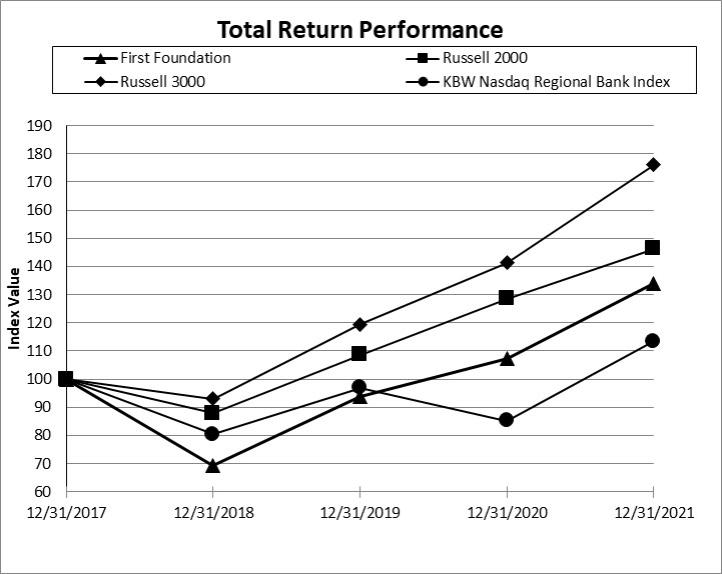NaN executive officers of FFB previously had minority interests in an entity which FFB uses for software services, for which FFB paid $0.6 million in 2021, $0.3 million in 2020, and $0.3 million in 2019.
As of December 31, 2021, a director owns a $70,000 portion of subordinated notes held at FFI.
The CEO of the Company is a director of another financial services company, and its financial institution subsidiary, that has deposits with the Bank and, in 2018 and 2017, purchased $52.1 million and $121.9 million of loans, respectively, from the Bank for which the Bank will continue to provide servicing. The balance of deposits held at the Bank was $0.2 million and $45.7 million at December 31, 2021 and December 31, 2020, respectively, and the interest paid by the Bank was $33,100 and $0.2 million in 2021 and 2020, respectively. The amount of loans serviced for this financial institution was $95 million at December 31, 2021. In 2017, the Bank participated in a subordinated note offering from the financial services company for $15 million. The Bank earned $0.8 million from this investment in 2021, 2020, and 2019.
NOTE 20: QUALIFIED AFFORDABLE HOUSING PROJECT INVESTMENTS
The Company began investing in qualified affordable housing projects in the last quarter of 2019. These investments may qualify for Community Reinvestment Act (CRA) credit and generate low income housing tax credits (LIHTC) and other tax benefits over an approximate 10 year period. The Company records these investments using the proportional amortization method and amortizes the initial cost of the investment in proportion to the tax benefits, and the net benefit is recognized in the income statement as a component of income tax expense.
At December 31, 2021 and December 31, 2020, the balance of the investment for qualified affordable housing projects was $59.0 million and $39.7 million, respectively. Total unfunded commitments related to the investments in qualified affordable housing projects was $45.2 million and $34.4 million at December 31, 2021 and December 31, 2020, respectively. The Company expects to fulfill these commitments between 2022 and 2033.
During 2021, 2020, and 2019, the Company recognized amortization expense of $3.6 million, $2.6 million, and $161,000, respectively, and recognized tax credits from its investment in affordable housing tax credits of $3.2 million, $1.5 million, and $61,000, respectively. These amounts were included within income tax expense. The Company had 0 impairment losses during 2021, 2020, and 2019.
NOTE 21: REGULATORY MATTERS
FFI and the Bank are subject to various regulatory capital requirements administered by the federal banking agencies. Failure to meet minimum capital requirements can initiate certain mandatory, and possible additional discretionary, actions by regulators that, if undertaken, could have a direct material effect on FFI and the Bank’s financial condition. Under capital adequacy guidelines and the regulatory framework for prompt corrective action, the Company and the Bank must meet specific capital guidelines that involve quantitative measures of FFI and the Bank’s assets, liabilities, and certain off-balance sheet items as calculated under regulatory accounting practices. Under a new comprehensive capital framework for U.S. banking organizations, which became effective on January 1, 2015, with certain of their provisions phased-in over a several years through January 1, 2019, the Company (on a consolidated basis) and FFB (on a stand-alone basis) are required to meet specific capital adequacy requirements that, for the most part, involve quantitative measures, primarily in terms of the ratios of their capital to their assets, liabilities, and certain off-balance sheet items, calculated under regulatory accounting practices. The net unrealized gain or loss on available for sale securities is not included in computing regulatory capital. FFI’s and the Bank’s capital amounts and classification are also subject to qualitative judgments by the regulators about components, risk weightings, and other factors.
Quantitative measures established by the regulators to ensure capital adequacy require FFI and the Bank to maintain minimum amounts and ratios (set forth in the table below) of total and Tier 1 capital (as defined in the regulations) to risk-weighted assets (as defined), and of Tier 1 capital (as defined) to assets (as defined). Management believes, as of December 31, 2021 and December 31, 2020 that FFI and the Bank met all capital adequacy requirements.



